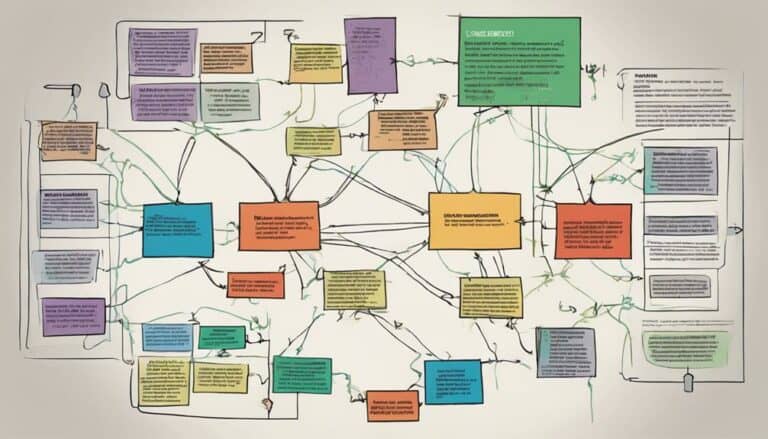When faced with complex decisions, organizations often struggle to maintain efficiency without a clear framework guiding their choices.
Consider a scenario where a company must decide between investing in new technology or expanding its workforce. By utilizing a structured decision-making framework, you can not only navigate such dilemmas effectively but also optimize outcomes.
The key lies in how these frameworks help prioritize objectives, allocate resources wisely, and align decisions with the organization's overarching goals.
So, how exactly can this structured approach revolutionize your organization's efficiency and set you on the path to success?
Key Takeaways
- Enhances decision quality and expedites processes through structured approaches.
- Provides clarity in decision rights and fosters transparency.
- Aligns day-to-day decisions with strategic goals for operational effectiveness.
- Incorporates data-driven choices, promoting accountability and efficiency.
Understanding Decision-Making Frameworks
To enhance organizational efficiency, understanding decision-making frameworks is essential as they provide structured processes for making informed and timely decisions. These frameworks serve as roadmaps, guiding you through the decision-making journey by breaking down complex choices into manageable steps. By clearly outlining the criteria for decision-making, assigning specific responsibilities, and establishing a consistent approach, decision-making frameworks reduce errors and streamline the entire process. This not only saves time but also guarantees that decisions are made in alignment with the organization's goals and values.
Additionally, decision-making frameworks can be tailored to suit your organization's specific needs, allowing you to maximize efficiency by customizing the processes to fit your context. This adaptability ensures that the framework isn't just a theoretical concept but a practical tool that empowers you to make decisions with confidence and precision. Embracing decision-making frameworks is the first step towards fostering a culture of strategic and effective decision-making within your organization.
Benefits of Utilizing Frameworks
Enhancing organizational efficiency through the utilization of decision-making frameworks offers a strategic approach to optimizing processes and achieving informed decision outcomes. Decision-making frameworks contribute to effective decision-making by providing a structured approach that aids in evaluating options based on predefined goals, criteria, and constraints. This clarity leads to improved decision quality and expedites the decision-making process, ultimately enhancing organizational efficiency.
One of the key benefits of utilizing decision-making frameworks is the improvement in communication, collaboration, and alignment within the organization. By establishing a common framework for decision-making, teams can work together more effectively towards a shared goal, reducing misunderstandings and conflicts. Additionally, decision-making frameworks guarantee that decisions are well-informed by considering various perspectives and potential outcomes, aligning them with organizational objectives. This alignment results in more consistent and well-informed decisions that drive organizational efficiency and effectiveness.
Implementing Frameworks Effectively
Implementing decision-making frameworks effectively requires a strategic approach that streamlines processes, clarifies roles, and aligns decisions with organizational goals, ultimately enhancing efficiency and productivity. To make successful implementation, consider the following key steps:
- Establish a Clear Structured Approach: Define a clear process for how decisions will be made within the framework, outlining the steps to be followed and the criteria for evaluating options.
- Clarify Roles and Responsibilities: Clearly define the roles of individuals involved in the decision-making process, specifying responsibilities and expectations to avoid confusion and streamline operations.
- Define Decision-Making Criteria: Establish specific criteria that decisions must meet to align with organizational goals, ensuring consistency and coherence in the decision-making process.
- Promote Transparency and Accountability: Foster a culture of transparency and accountability within the organization by making decision-making processes visible and holding individuals responsible for their actions, enhancing communication and collaboration.
Selecting the Right Framework
Selecting the appropriate decision-making framework involves aligning organizational goals and objectives with the framework's compatibility with the organization's culture, values, and decision-making style. By choosing a framework that resonates with these key aspects, you can greatly enhance efficiency within your organization. Tailoring the decision-making model to fit your organization's specific structure and needs is vital for streamlining processes, reducing ambiguity, and ultimately improving operational effectiveness. This strategic alignment ensures that decisions are made in a manner that is consistent with your organizational values and culture, leading to more informed decisions and better outcomes. Below is a table highlighting the important factors to consider when selecting the right decision-making framework:
| Key Aspects | Considerations | Benefits |
|---|---|---|
| Organizational Goals | Ensure alignment with the framework's objectives to drive the organization towards its targets. | Enhanced focus and goal achievement |
| Organizational Culture | Evaluate compatibility with the existing culture to facilitate seamless integration. | Improved acceptance and adoption |
| Decision-Making Style | Match the framework with the organization's preferred decision-making approach for better results. | Increased efficiency and effectiveness |
Enhancing Organizational Efficiency
To maximize operational efficiency in your organization, it's essential to integrate a well-suited decision-making framework that aligns with your goals, culture, and decision-making style. Here are four key ways in which enhancing your decision-making processes can improve organizational efficiency:
- Clarity in Decision Rights: Clearly defining who's the authority to make specific decisions helps in avoiding delays and confusion, leading to streamlined processes and faster outcomes.
- Transparency and Accountability: Implementing a decision-making framework fosters transparency and accountability within your organization, ensuring that decisions are made based on relevant information and in alignment with organizational objectives.
- Data-Driven Choices: By incorporating data-driven approaches into your decision-making processes, you can make informed choices that are more likely to lead to successful outcomes, thereby increasing organizational efficiency.
- Alignment with Strategic Goals: Effective organizational decision-making frameworks help in aligning day-to-day decisions with the strategic goals of the organization, ensuring that efforts are focused on achieving long-term success and efficiency.
Conclusion
By implementing a decision-making framework, you can streamline processes, boost productivity, and uphold ethical values. Selecting the right framework and effectively implementing it can lead to consistency, improved risk management, and enhanced customer service.
Embrace the benefits of utilizing frameworks to enhance organizational efficiency and achieve your objectives. Make the move to maximize efficiency and make impactful decisions with a structured approach.

